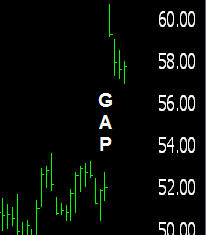Psychology of Overbought, Oversold, and Market Extremes
July 28, 2009 at 8:26 am
 Ever seen something get just a little overdone?
Ever seen something get just a little overdone?
Perhaps it was that weekend barbecue, or the tattoo collection on that dude you saw the other day.
No doubt, we all run across the occasional extremes, and they’re usually worth a story or two.
It happens in the market too. Bounces get a bit stretched and before you know it, you’re staring at overbought conditions. And sometimes selloffs spark a little more damage than usual, creating oversold conditions.
We don’t see ‘overbought’ and ‘oversold’ every week, but it happens regularly. Emotions are a primary driver of the price action, so it’s no surprise that at times they challenge the boundaries of ‘normal’ and produce market moves with an unsustainable pace.
Every now and then, we’ll see true extremes in the market. Sometimes it’s when the upside momentum runs so hot that it produces a parabolic uptrend. Some of the fastest money on the long side can be made during such times, but high risks are there right along with those rewards. It’s somewhat of a party atmosphere though. Feels like it might not ever end.
And of course at times we do see selloffs become all-out panics, when capitulation prompts everyone and their dog to sell. When it happens, it can be rather spooky to see. Feels like it might not ever end.
What’s the Difference?
There are definitely various degrees of strength and weakness in the market, so let’s take a little deeper look and see what we can pick up and apply going forward.
The fact of the matter is that whether we’re discussing overbought or oversold conditions, or parabolic uptrends or all-out capitulation, the moves in price are happening at an unsustainable pace.
That means it might continue for a little longer, but not forever. Eventually, some kind of recoil or pullback or reversal is going to arrive, ending the move. Another might follow in the same direction, but the point here is that price doesn’t move in a straight line forever.
With that said, the biggest factor in determining exactly which condition we’re seeing is going to be the timeframe being referenced.
For example, on an intraday 5-minute chart, a parabolic uptrend can occur. That same move may leave the daily chart of the same stock hardly even overbought. So looking under the microscope won’t often correspond to the big picture view.
Faces in the Crowd
As we examine these conditions, it’s crucial that we take notice of all parties involved: the buyers, the sellers, and those who are short. Knowing who’s involved and being able to continually evaluate their likely motivations can give us a big edge as traders. It means we’ll be better prepared for knowing if the move might persist, or if instead we need to be on watch for a sudden shift. Let’s look at a few situations and the roles which matter most…
First though, a brief description of how I’m using these terms:
Buyer – a bull with cash on hand who wants in.
Seller – a bull with inventory (shares) on hand who wants out.
Short Seller – a bear wanting to get in and profit from a decline.
Overbought:
Buyers – they’ll be greedy and eager to buy the first dip. In an overbought market, the bulls are correct and anxious to add to their positions. They view it like they’re defending turf, so give them some respect until they show signs of tiring out.
Short Sellers – they’re using strength to initiate reversal plays, but walking the tightrope. Understanding that they’re putting on short sales at the near-term highs means they’ll likely be quick to cover if more strength arrives.
Oversold:
Sellers – they’ve quasi-panicked and dumped when they shouldn’t have, adding some fuel to the fire. Once they see a bounce or some stability, they’ll likely get long again. If the bounce fails, they’ve just compounded their mistake, perpetuating the cycle.
Buyers – they’re trying to ‘buy low’ but struggling, because with each new low in price they get spooked and jump ship again. If a little more pain can be inflicted, they’ll give up. At that point, they’re vulnerable to getting caught very off guard.
Parabolic Uptrend:
Buyers -this is all-out greed. They’re making money hand over fist, and see no end in sight. The upside pace has increased, as has their desire for more, and they have no idea that the edge of the cliff is fast approaching. Once it arrives, they’re in for a shock and they’ll rush for a chair as the music stops.
Short Sellers – early = wrong. They’ve recognized the unsustainable pace of the advance, and they know they stand to benefit big if they can simply time their entry well. Unfortunately, their confidence is battered at this point, as is their account. They’re wounded but staying attentive for an opportunity which will quickly increase their boldness.
Capitulation:
Sellers -regrets, regrets, regrets. Repetitive questions of “why didn’t I sell back at $__” plague this crowd, and they’re absolutely sick of getting beaten up. They’re throwing in the towel, and planning to buy a small used boat with what’s leftover. It’s been a long road for them, but the pain isn’t over because as the low gets established and price rebounds without them, their ego takes one last significant hit.
Buyers – what began as a bold get-in-front-of-the-freight-train move has chipped quickly away at their equity as time after time new lows stop them out. But with some dry powder still available, they sense a chance to pick up some bargains with potential. If they can only endure the foul smell of a sick market and go completely against the crowd, it’ll pay off big so they hang around and keep trying until their ship comes in.
The Biggest Question
Are you in the habit of evaluating not only the conditions you’re trading in, but also the participants at any given point in time? Understanding what the flip side is thinking will help keep you grounded and more aware of whether it’s time to hold ’em or fold ’em!
Thanks for stopping by and I’ll see you here soon with more. Until then…
Trade Like a Bandit!
Jeff White
Are you following me on Twitter yet?
Protect Capital Even in a Bull Market
July 27, 2009 at 8:03 am
 This market sure has been strong – we have yet to see a pullback which has lasted longer than a few minutes!
This market sure has been strong – we have yet to see a pullback which has lasted longer than a few minutes!
Instead, we’ve merely seen brief pauses of sideways price action, which is quite nice…if you’re long.
A powerful market like this does have a downside though, which is fewer quality setups for new long side entries. And shorting? Well, let’s just say some feelings have been hurt for the bears!
We’ve come a long way since the July 8th lows, and right here, it’s very easy to chase stocks if you want to get long. It feels like it almost can’t go down (famous last words), and thus confidence is really high. But that doesn’t make buying here a good decision. In fact, sometimes it’s best to actually let the market come to us after such a move.
Protecting capital is the top priority of all successful traders. Making money is secondary.
Even strong bull markets like what we’re seeing right now require that we protect capital. It’s easy right now to think making money on the long side must be easy when the market rallies almost daily.
But trading out of fear that the market will run off and leave you behind is a recipe for forcing trades, which will usually cost you more money than it’ll make you!
Stay Focused
Our job as traders is to take only the best setups with the highest reward and lowest risk associated with them.
Keep that in mind here, as the market remains quite extended on a short-term basis. Manage your open positions the best way possible, and be willing to patiently let the market come to you. Once it does, then set up new trades.
There will be plenty of good setups in the next few days and weeks, but it isn’t wise to lower your standards and buy stocks that are technically extended just to get long.
A lasting bull move will offer plenty of chances to buy, and that’s best done on pullbacks or after resting phases. If this breakout sticks, we should see many opportunities in the weeks to come.
Thanks for stopping by and I’ll see you here soon with more. Until then…
Trade Like a Bandit!
Jeff White
Are you following me on Twitter yet?
Video Review of the Indexes 7-26-2009
July 26, 2009 at 4:43 pm
Moving out of a multi-month trading range has been a very welcomed sight for many traders in the past week. It has meant an expansion in volatility, greater momentum than we’ve seen in a while, and new recovery highs for the market from the March low.
However, the way in which it has happened obviously caught quite a few people off guard. The emotions have combined for a panic buying atmosphere, ripping bears in the process while sparking fears among bulls with cash that prices may never again retreat.
That’s not a logical view of course, but anytime there’s a big move taking place it’s common to see emotions behind the action.
Nonetheless, the indexes are getting back on the move. And although a rest or pullback from here would be welcomed and healthy, we’re still waiting on it to arrive. While we wait, it’s a great time to examine some important levels for the indexes to keep an eye on in the days ahead.
This clip was also posted over on the Trading Videos site (as always), and perhaps you’ve seen it there – but in case you didn’t, I wanted to put it here on the blog for you.
Let me highly suggest clicking the “HD” on the video player and then going full-screen for best quality.
Thanks for stopping by and I’ll see you here soon with more. Until then…
Trade Like a Bandit!
Thanks for stopping by and I’ll see you here soon with more. Until then…
Trade Like a Bandit!
Jeff White
Are you following me on Twitter yet?
Rip City – When Will We Rest?
July 23, 2009 at 12:44 pm
Shorts are getting torched right now. The extreme momentum we’re seeing is definitely of the emotional variety, although it’s been technically significant as well.
Today, for example, the NAZ is going for its 12th straight advance – an impressive feat which has brought about a 14% move from the low set earlier this month.
We’re very stretched right now to the upside in the short term, and yet there could still be more.
So the biggest question on everyone’s mind right now – both bulls and bears alike – is “when will we rest?”
The notion of a pullback after a move of this magnitude isn’t crazy. It’s logical to expect at least some profit-taking after such a huge surge. But we’re still looking for one.
And given that the technicals are taking a back seat to emotions right now, it makes it tougher to determine when a dip might develop into something a little more than just a 15-minute slide.
Fortunately, there’s one situation in play right now that could offer a sell signal for a quick trade.
Just a little while ago over on the trading videos site, I posted the following video. In it, I discuss this topic and offer a rare clue to watch for when it comes to expecting a little deeper pullback than just a few points.
Let me highly suggest clicking the “HD” on the video player and then going full-screen for best quality.
Just remember to wait until this pattern confirms, because until that happens there’s still upside momentum that deserves the utmost respect.
Thanks for stopping by and I’ll see you here soon with more. Until then…
Trade Like a Bandit!
Jeff White
Are you following me on Twitter yet?
Fill Your Trading Toolbelt
July 20, 2009 at 9:52 am
Recently I saw the movie Gran Torino, and really enjoyed it.
In case you haven’t seen it, I won’t give away the plot. But at one point of the movie, Clint Eastwood is with a young man in the garage and the kid is amazed by the amount of tools Eastwood has collected.
Nearing age 80, Eastwood is quick to remind the young man that those tools weren’t all bought at once – that his collection was slowly built over time on an as-needed basis.
Taking the young man to the hardware store, Eastwood buys him a tool belt and a couple of things he’ll need for a new construction job. Again, he reminds the young man that he will acquire more tools over the years as he comes to need them.
Every Trader Has a Toolbelt
So what kind of shape is your trading tool belt in? Are you locked and loaded, ready for whatever the market throws at you?
Or do you have just a couple of basics which you’re relying on with plenty of room for more on your hip?
It’s worth asking yourself, and taking a personal inventory as well as a strategic inventory for your trading will let you know which situations you should be involved in, and equally important, which situations you should be avoiding.
I use this analogy because it’s so obvious. There are many ways to skin the market cat, but you don’t have to know them all at once. Get really good at 1 or 2, and rely on them for consistency in the early stages of your trading career. But don’t forget to keep an eye out for new possibilities which are emerging around you – because they will.
And as you begin to notice more opportunities and situations to profit from, figure out how to (1) locate those plays, and (2) trade them in a way so as to appropriately manage your risk and maximize your reward. That’s crucial.
As you add the occasional new strategy to your tool belt, you’ll find it gets heavier over time, thereby enabling you to attack more and more situations effectively. Like a veteran. But don’t pressure yourself to get there overnight – it takes time.
Thanks for stopping by and I’ll see you here soon with more. Until then…
Trade Like a Bandit!
Jeff White
President, The Stock Bandit, Inc.
Swing Trading & Day Trading Service
www.TheStockBandit.com
[tags]Stock Market, Day Trading, Stock Trading, Investing, Swing Trading[/tags]
Video Review of the Indexes 7-19-2009
July 19, 2009 at 4:19 pm
What a move last week, huh? A 7% spike across the board in the indexes is certainly one way to get the attention of traders.
Especially those caught short after the creation of lower highs and lower lows in recent weeks.
We’ve got a new week fast approaching, and anything goes. That means it could be a dull, quiet week with no momentum. Or it could be another rip-roaring surge to new multi-month highs. Or something else.
That’s a big part of why I’m a trader – there’ll be opportunity to profit no matter what happens. As long as you show up!
This clip was also posted over on the Trading Videos site (as always), and perhaps you’ve seen it there – but in case you didn’t, I wanted to put it here on the blog for you.
Let me highly suggest clicking the “HD” on the video player and then going full-screen for best quality.
Thanks for stopping by and I’ll see you here soon with more. Until then…
Trade Like a Bandit!
Jeff White
President, The Stock Bandit, Inc.
Swing Trading & Day Trading Service
www.TheStockBandit.com
[tags]Stock Market, Day Trading, Stock Trading, Investing, Swing Trading[/tags]
Managing Gap Risk
July 15, 2009 at 8:25 am
 It’s a simple fact that stocks gap. The indexes gap. The news flow causes it, upgrades and downgrades cause it, and even just excitement or fear at times will cause stock gaps.
It’s a simple fact that stocks gap. The indexes gap. The news flow causes it, upgrades and downgrades cause it, and even just excitement or fear at times will cause stock gaps.
There are common gaps, which tend to be small, and then there are of course bigger, harsher gaps like breakaway gaps or runaway gaps.
Alot of these actually do end up getting filled, whether quickly or eventually, but let’s talk about one major cause of sizeable gaps: earnings season.
Right now we’re getting into the thick of earnings season, which is a few weeks long after the end of the quarter. Companies need to report their results for Q2 and let shareholders know how business is going.
Business, schmizness…I’m a trader.
The Importance of the Clock
So while I don’t really care much about the business environment for XYZ Corp., I have to recognize that holding a position into that earnings report means one thing – the inability to manage my risk.
With company-specific news set to be released imminently, I know that the stock is likely to bolt one direction or the other. That’s not such a big deal in itself, but the problem is that earnings reports primarily occur outside of market hours.
That means by holding a stock overnight when they’re set to report earnings (whether after the closing bell or before the next day’s opening bell), I’m inviting a big gap to come along. Even worse, I can’t do anything about it.
Maybe it results in “free” money for me if the stock goes my way, but it could just as easily result in a black eye – or the loss of a limb! Have you seen some of these earnings gaps?
So what I do to manage the gap risk associated with earnings is simple: I do not hold a stock going into earnings.
Not a dramatic enough answer for you? Well, what are you in the market for…money or excitement?
Why Do You Trade?
If it’s profits you want, then you care about preserving capital and managing your risk whenever that capital of yours is on the line.
But of course if it’s excitement you’re after, then you just want a story to tell – and you’ll get it when you hold positions into earnings reports. Only problem is, nobody really wants to hear about it.
The Visual Version
Last night over on the trading videos site, I posted the following video. In it, I discuss this topic and offer a practical way to manage gap risk during earnings season.
Let me highly suggest clicking the “HD” on the video player and then going full-screen for best quality.
And here are 3 earnings calendars I reference in the video, they’re certainly worth bookmarking:
EarningsWhispers.com
Yahoo Finance
Earnings.com
Thanks for stopping by and I’ll see you here soon with more. Until then…
Trade Like a Bandit!
Jeff White
President, The Stock Bandit, Inc.
Swing Trading & Day Trading Service
www.TheStockBandit.com
[tags]Stock Market, Day Trading, Stock Trading, Investing, Swing Trading[/tags]






